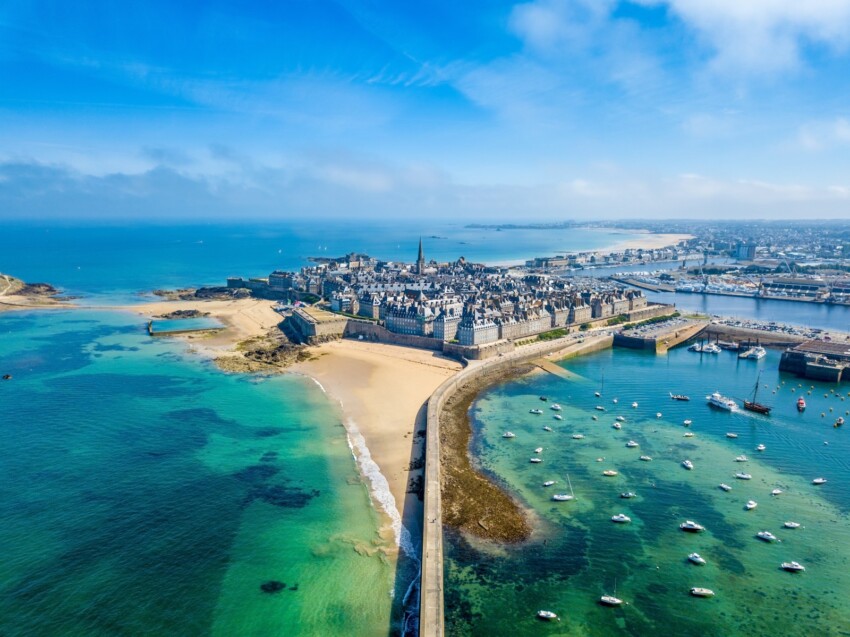

Brittany is divided into four departments: Finistère, Côtes d’Armor, Morbihan and Ille-et-Vilaine. Loire-Atlantique historically belongs to Brittany but, administratively, is part of the Loire Valley region.
Brittany is by far one of the most fascinating regions of France. Surrounded by the stormy Atlantic Ocean and proud of its culture of Celtic origin, which has forged its traditions, its language and the strong-willed character of its inhabitants, Brittany is home to a territory rich in diverse and enchanting landscapes.
Picturesque fishing villages, overlooking tiny hidden bays, alternate with verdant countryside dotted with medieval villages, often perched and fortified. The windswept moors and large unspoilt forests have nurtured legends and myths linked to the Celtic culture, rich in sagas and tales. The sandy beaches with turquoise sea and wild cliffs are interrupted by ancient medieval towns, imposing castles, archaeological sites and absolutely spectacular nature.

The marvellous town of Saint Malo retains its charm as a fortified corsair citadel, protected by mighty walled ramparts, which can be explored entirely on foot.
Whipped by the stormy waves of the sea, proud of never having been conquered, today Saint-Malo has become a must-see seaside resort on the Costa Smeralda, with its coastline bordered by fine sandy beaches.

An enchanting city of art and history, Dinan preserves a magnificent architectural heritage, perfectly preserved: an enchanting medieval atmosphere awaits you, benefiting from the extraordinary setting on the banks of the Rance river.
Just a few kilometres from Rennes, the largest medieval town in Brittany amazes visitors with its location, perched 75 m high on a rocky spur overlooking the river and crossed by a spectacular viaduct.

Life in the picturesque town of Cancale is closely linked to that of the sea: it is a lively seaside resort, but above all a small fishing port and a renowned oyster centre, located between Saint-Malo and Mont-Saint-Michel.
Tourists come from all over Europe to appreciate the beauty of the Emerald Coast, the finesse of its oysters and the quality of its gastronomy.

This stretch of the Cote d’Armor is one of Brittany’s hidden jewels. Between Ploumanac’h and Perros-Guirec stretches the Pink Granite coastline, an absolutely unique coastline in Europe: huge blocks of granite, with incredible shades of pinkish colour, have been shaped by the weather into bizarre shapes.
The 8-km-long footpath, a section of the customs path linking the two locations, encompasses a stupendous alternation of small bays with turquoise sea, impressive lighthouses, views of the islands, hidden coves framed by dense vegetation.

The GR34, known as the Customs Trail, is a famous hiking trail, which runs along the entire Breton coast for almost 1,700 kilometres: starting from Mont-Saint-Michel, it reaches Saint-Nazaire in the Loire Atlantique.
Unless you have several weeks to spend and considerable preparation, you are unlikely to be able to walk it all: but there is the possibility of taking only a few small sections, the most scenic and spectacular ones.

In the heart of Brittany lies a mysterious forest: of all the legendary places linked to Celtic culture, the forest of Paimpont or Brocéliande has always preserved its legendary aura, rooted in the myth of King Arthur, Merlin and the Knights of the Round Table.
In this marvellous and lush undergrowth, according to local tales, live fairies, korrigans and other elves that only those who are guided by magic will be able to see. Following numerous walking trails, you can explore the forest and admire the places that have fuelled the legends and stories of magic.

The lively town of Carnac, overlooking the Gulf of Morbihan, happily combines the richness of its historical heritage and the pleasures of the sea, thanks to its privileged location by the sea.
Inland, you can visit the Carnac alignments, the largest megalithic site in the world. Dating back to around 4,500 B.C., located on 3 adjacent sites, more than 3,000 menhirs are positioned perfectly aligned in precise rows. A plunge into the history of this fascinating region.

The historical capital of Cornouaille and Finistère, Quimper is a spectacular medieval town, located at the confluence of the Steïr and Odet rivers.
Framed by a splendid cathedral, it is famous for its handmade majolica tiles made by local craftsmen and for its characteristic old town centre. Quimper’s old quarters, with their cobbled streets and beautiful half-timbered houses, recall its medieval origins.

Vannes, the ancient city of the Dukes of Brittany, harmoniously combines a heritage rich in history with the beauty of the Gulf of Morbihan. The city has always played an important role in history and is still an essential stop on your trip to Brittany.
With its walled ramparts, manicured gardens, medieval old town and charming little squares, Vannes enchants with its ancient soul, all to be discovered on foot.

With its incredible concentration of perfectly preserved old half-timbered houses that remained intact after the gigantic fire of 1720, Rennes is one of the most beautiful towns in Brittany.
Rich in history and ancient corners, the city is considered the capital of Brittany for its incredible historical and cultural heritage.

The Quiberon peninsula offers a beautiful contrast between its wild coastline and the sandy beaches of its bay, suitable for water sports and a famous seaside resort.
Here, picturesque villages, busy harbours, idyllic countryside and thalassotherapy centres suitable for wellness and relaxation alternate.

Concarneau and its fabulous Ville Close, the walled city, is one of the most beautiful jewels of the Cornouaille. The town is both a large port city and a popular Finistère seaside resort.
The old town, firmly anchored in its medieval past and perfectly preserved, is also an important nerve centre linked to the sea and fishing.
In the following map you can see the location of the main places of interest mentioned in this article.







